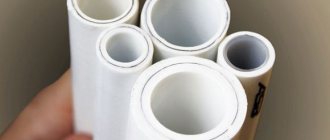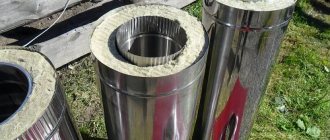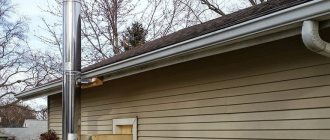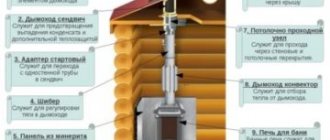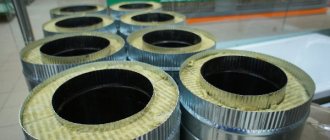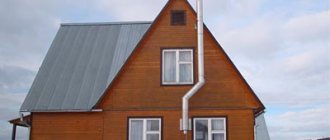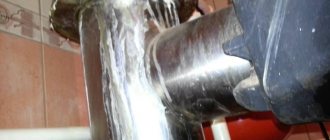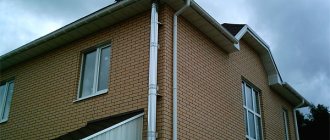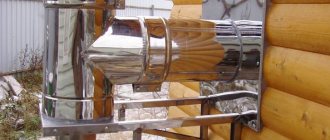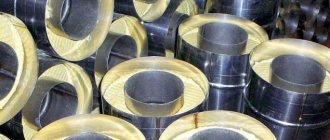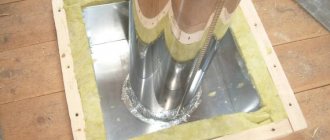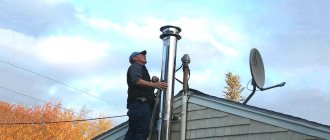Sandwich pipes are the optimal solution for efficient chimney operation. They are a cylindrical structure consisting of a pair of metal pipes of different diameters, inserted into one another. To avoid excessive heating of the outer shell, a layer of non-combustible insulating material is installed between them. The presence of two protective layers almost completely protects the interior from condensation.
Sandwich pipes for chimneys are the most popular solution today
How does a sandwich pipe for a chimney work?
Chimneys are mandatory elements for installation on all types of stoves and fireplaces. What are sandwich pipes used for? They are intended to remove smoke and other products harmful to the health of living beings generated during the combustion process into the atmosphere.
The structure, which usually has a circular cross-section, is composed of the following components:
- internal metal circuit, resistant to high temperatures. It also provides other structural elements with protection from condensation. The diameter of the internal circuit connected to the stove (fireplace) is usually 200-280 mm; for a heating boiler with a power of less than 40 kW, a product with an internal cross-section of 130-200 mm is selected ;
- a high-strength outer metal layer that protects the structure from destructive external influences;
- an insulating layer of insulation laid between the layers to prevent overheating of the outer surface.
Note! The thickness of the layer (from 30 mm) affects the temperature of the outer pipe. When a chimney is installed outside a building, the insulation is done more thoroughly.
If the sandwich pipe is intended to be installed on a furnace, then the kit is equipped with additional components:
- knees. Available with direction angles of 45º and 90º;
- cone They ensure free flow of precipitation;
- tee with angles 45º and 87º;
- revision. Being installed on a stand (wall or floor) at the base of the chimney, it provides the ability to maintain its functionality and control;
- spark arrester;
- deflector;
- fungus;
- unloading platform;
- brackets;
- clamps.
The basis of the sandwich type chimney module is two steel pipes inserted into one another
Peculiarities
Today, sandwich chimney pipes are increasingly used in heating systems. This is due to the high quality of the materials used, the performance and long service life of the structure, and its aesthetic appearance. Sandwich pipe is used throughout.
Installation of a sandwich pipe for a chimney
The interesting name of the “sandwich” pipes fully reflects the design principle. The chimney includes three layers, namely a pair of pipes that are located one inside the other, and thermal insulation that is laid between them. Stainless steel sandwich pipes have their own individual properties, which is why they are often preferred.
Installing a chimney with one layer is often irrational during house construction work. There are reasons for this, the main one is the accumulation of water vapor due to temperature differences between the combustion products that are removed from the premises and the air outside the walls of the home.
When using a sandwich type stainless steel chimney pipe, this issue is resolved by itself due to the presence of an insulating layer, which has a low thermal conductivity coefficient. However, it is still worth installing a condensate collector.
The thickness of the insulating layer should be at least 25 mm, but can reach 60 mm.
Sandwich pipes are available in different sizes, so choosing the right model based on diameter and length is not difficult. The range of this type of device includes various connection elements. Thus, connecting all corners, extensions and adapters will be easy and simple.
The effectiveness of removing combustible products from a living space will depend on the number of obstacles (pipe bends and turns) that are in their path. The ideal option is a single 90-degree upward turn. In cases where this is not possible, try to keep the number of turns to no more than three.
The service life of a sandwich pipe for a chimney, according to various estimates, is 10-15 years. However, user reviews often prove that it is necessary to replace the chimney after 5 years if it burns out.
The reasons for such a short service life may be different. This is both a manufacturing defect and an incorrectly selected type for a particular boiler.
In order for the structure to be operational for as long as possible, it is necessary to carry out preventive cleaning on time.
You can read about the features of ceramic chimneys here.
How to choose a sandwich pipe and other components
When purchasing individual elements for arranging a chimney, it is advisable to obtain a factory certificate containing technical characteristics, names of boilers to which connection is allowed, types of fuel used and warranty periods for operation. Manufacturers of quality products always include the necessary fastenings for modular elements and deliver them in reliable packaging.
For the manufacture of sandwich pipes, materials that are resistant to corrosion are used. Combustion products entering the chimney contain a certain amount of chemically active substances - sulfur, sulfuric and hydrochloric acids. Under their influence, ordinary steel will quickly oxidize and burn out. Therefore, high-alloy stainless steel with a thickness of at least 0.7 mm is used for the inner pipe and half a millimeter for the outer contour. The inner circuit should:
- maintain a temperature of 850º C for a long time;
- cope with a short-term one and a half times increase in temperature.
AISI 321 steel is considered to be the highest quality, which, like its Russian counterparts, contains a significant proportion of molybdenum, differing in:
- maximum resistance to acids;
- high temperature resistance;
- ability to withstand centuries of use.
Chimneys made from the strongest steel are used even in industrial environments at high temperatures
The most common products are made from AISI 430 steel, which can withstand short-term temperature surges of up to 900º C. It is designed for ten to fifteen years of use, but has a great advantage in terms of cost.
Good to know! If there is no marking on the pipe, the quality of the steel can be checked by applying a magnet, to which steel with alloying additives should not react. Its matte or polished surface will not lose its shine over time.
It seems more economical to use enameled pipes, which are less heat-resistant and resistant to acids. They are considered quite suitable for connection to:
- heating boilers;
- heating columns;
- stoves and fireplaces operating as usual.
An economical option is also the use of combined sandwich pipes, in which the inner pipe is made of stainless steel, and the outer pipe is galvanized or enameled.
Galvanized internal pipes are suitable for boilers operating on gas fuel, and the external seam can be obtained by rolling. For solid fuel boilers, you need an internal stainless steel pipe with a laser-welded seam. It is necessary to take into account the diameter of the boiler pipe onto which the sandwich pipe is placed.
Thermal insulation material is selected in such a way that it does not deform at a temperature of 650 degrees. To ensure fire safety and protect the chimney from freezing and condensation, it is advisable to set its thickness to at least five centimeters. For insulation it is supposed to use:
- basalt wool. The most economical proposal, but the temperature should not rise above 600º C;
- vermiculite. Lightweight material with good thermal insulation properties, maintained in the range from -250º C to 1150º C;
- ceramic wool. The fibers of the material were given special deformation, thermal and chemical resistance. At a higher cost, the advantage of ceramic wool is its ability to withstand temperatures up to 1260º C.
Pipes differ in their inner layer, which determines the maximum operating temperature of the finished chimney
What it is
Essentially, these are two pipes of different diameters, inserted into each other and delimited by a layer of heat-resistant basalt wool. Some craftsmen, many years ago, established their own production of sandwich chimneys at home, but then it was significantly complicated by the need to use glass wool as insulation, which had a whole list of disadvantages.
Today there is no such problem, and there are a huge variety of heat-resistant insulation materials. This means that it is quite possible to organize independent production of sandwich chimneys. The only difficulty is the alignment of the pipes and their reliable fixation, although even large manufacturers often neglect this and certain difficulties may arise during the installation process.
To understand what a chimney made from sandwich pipes is, you can watch the video in this article
Let us highlight several significant advantages of a multi-layer chimney.
Advantages and disadvantages of sandwich pipes
The use of sandwich pipes when installing chimneys allows you to:
- do without a base, which is necessary when making a brick or ceramic structure;
- carry out all necessary work, regardless of the time of year;
- install a chimney from the boiler, regardless of the fuel used;
- give the structure any configuration and not worry about complexity;
- achieve the highest possible fire safety;
- installation is simple and convenient, thanks to the presence of a large number of connecting elements, of the same quality as the pipes;
- effectively reduce heat loss;
- avoid damage due to condensation;
- exclude the influence of natural conditions on the interior of the structure;
- get rid of the occurrence of hum and noise during drafts;
- limit yourself to cleaning soot without resorting to constant repairs and replacement of elements;
- get an environmentally friendly design;
- create an aesthetically attractive look.
The disadvantages include:
- decreased tightness due to the response of sections to temperature changes by contraction and expansion;
- relatively high cost of components of the structure;
- the possibility of operation for no more than fifteen years, which is significantly less than that of conventional chimneys. Although structures made from high-quality materials can last several times longer.
The sandwich chimney has an aesthetic appearance and does not require additional decorative finishing
Calculation procedure
To determine the diameter of the sandwich pipe, it is necessary to know in advance the conditions under which the operation will be carried out. Based on the size of the area of the heated room, a stove suitable for productivity is selected. To heat 10 sq.m. 1 kW of power is needed, respectively, for a room of 50 sq. meters, a 5 kW oven is suitable.
The temperature of the exhaust smoke depends on the type of heating boiler and the fuel used. The more degrees in the chimney, the more it heats up. The table clearly shows the relationship between temperature height and type of heating device.
Smoke temperature in different boilers:
| Type of heating boiler | temperature , C |
| Stove-fireplace | 350-650 |
| Sauna stove | 400-700 |
| Pyrolysis boiler | 160-250 |
| Pellet boiler | 120-250 |
| A gas boiler | 120-200 |
| Diesel boiler | 150-250 |
| Coal boiler | 500-700 |
*
In a sandwich chimney, the inner pipe heats up the most, so first of all, choose its diameter. The more powerful the oven, the wider it should be. As power increases, the internal hole must also increase. The power calculation can be seen in the table:
Average values of the ratio of boiler power and chimney cross-section:
| Boiler power, kW | Chimney cross-section, mm | S output diameter, sq. mm | Pipe diameter |
| less than 3.5 | 140 x 140 | 19 600 | 158 |
| 3,5 – 5,2 | 140 x 200 | 28 000 | 189 |
| 5,2 — 7 | 140 x 270 | 37 800 | 220 |
For open fireboxes, the smoke channel must exceed 1/100 of the boiler volume. In closed boilers, where air enters the firebox from the lower ash pan, the internal area of the chimney outlet must exceed the size of the supply opening. If the diameter exceeds the calculated one by one and a half times or more, then the traction force drops, and vortices form inside the chimney.
The arrangement of layers in sandwiches allows you to isolate the outer pipe from high temperatures, technical characteristics prevent the formation of condensation. Stone wool is non-flammable, its thickness depends on the temperature of the exhaust fumes from 25 mm at 60 C to 100 mm at 600 C.
Features of installing insulated sandwich pipes
When installing a chimney with a sandwich, a number of nuances are taken into account to ensure the duration and safety of its operation. First of all, you need to achieve traction stability:
- the chimney must reach a height of at least five meters;
- the head of the pipe must be raised to a height of more than half a meter above the surface of the flat roof (on a pitched roof, a one and a half meter distance to the ridge must be maintained);
- It is advisable to install the structure strictly vertically. The presence of inclined sections (45º) is acceptable ;
- connection to the heating unit is made at an angle of 2º. The length of this almost horizontal section is up to one meter, but it can be doubled if the chimney height exceeds five meters;
It is important to know! The length of horizontal sections in the structure should not exceed two meters - for a stove or fireplace, three meters - for a heating boiler.
Having solved the problem with traction, do not forget about some other features:
- It is prohibited to connect a chimney made of stainless steel to heating units operating on coal fuel;
- the channel design should not pass near flammable materials;
- placing galvanized products in living rooms and in rooms with high humidity levels is unacceptable;
- if the height of the chimney exceeds one and a half meters, it is advisable to secure it more securely by using tension clamps or erecting a support mast;
- sealant for joining seams must withstand an operating temperature of 1000º;
- each section of the pipe joining with the chimney structural elements is strengthened with a clamp;
- the strength of the structure is maintained by installing wall brackets at intervals of two meters along the length of the channel;
- the tee is installed on the support platform or console;
- any structural elements containing flammable materials at points of contact with the pipe are insulated or indented;
- the section coming from the heating unit should not have insulation;
- By placing most of the structure indoors, they achieve a reduction in the temperature difference, therefore, the heating efficiency increases.
After completing the installation and starting operation, you should remember that it is unsafe:
- use sections of the chimney to dry clothes or household utensils;
- using construction waste as fuel, items whose coating contains paints or varnishes, etc.
There should be no flammable materials around the chimney, and the place where the pipe exits through the ceiling is equipped with a metal apron
Installation
The assembly of a sandwich chimney, like any other, begins from the stove, where a special transition is connected. It is necessary because the temperature near the furnace is much higher than at a distance.
We coat the furnace pipe with heat-resistant sealant, after which we put on the transition and tighten it tightly with a clamp. Next, we move on to installing the knee.
If we are talking about the passage of pipes through the house, then in the area of the turning elbow a support bracket for a sandwich chimney is needed. It is fixed to the wall in such a way that the elbow is slightly tilted outward, three degrees is enough, this is done so that the accumulating condensate does not fall into the oven, but accumulates in the bend, where it evaporates at high temperatures.
By the way, if you use an elbow as shown in the photo, then the angle of inclination is not required, since it is initially equipped with a “sump”.
When the knee is fixed, install the first straight segment. An important nuance at this stage is how the pipes are connected. The first two connections must be in sequence, with the next pipe fitting onto the previous one, and not vice versa.
This connection allows smoke to escape freely through the chimney, and the joints between the pipes do not stop it.
The riser should be fixed at least every two meters, but if the ceilings in the room are low, then you can do without additional fasteners.
Installing a chimney inside a building
The process of attaching a sandwich pipe begins by connecting the coupling to the chimney opening of the heating unit. By installing an enlarged adapter, increased heat transfer and reduced heating of the chimney are achieved. Next, the horizontal section of the pipe or tee is secured. After which, having installed the tee, its lower part is closed with a very necessary plug, by removing which it will be possible to periodically remove soot.
The passage through the roof is carried out in the following sequence:
- A hole is made, which will most likely need to be further reinforced.
- Installing a roof trim will allow you to easily arrange a roof passage. The roof trim should fit closely to the base of the roof, the edges of the structure should be placed under the ridge (trimming).
- The inner side is equipped with an under-roof metal sheet.
- To make the structure completely sealed, an adjustable apron is attached to the roof groove.
- Having equipped a hole for the passage of a vertical pipe, install an adapter. A straight pipe is passed into the prepared hole from the attic or from the street. Docking modules while passing through the ceiling is prohibited. The next work proceeds after completion of insulation of the space between the pipe and the ceiling with fire-resistant materials. Subsequently, the area is plastered and painted over.
- Moving on to work in the attic and roof, assembly is carried out by lowering the pipes from above and joining them with the lower modules to avoid condensate entering the channel.
Important! The upper part of the structure is crowned with a cap to prevent birds from making a nest and small debris and precipitation from getting inside the pipe.
Installation of the outer part of the pipe is done last.
Tools and equipment
*
To assemble a high-quality chimney, you need to prepare the necessary tools and materials:
- a set of pipes for assembly with components for the roof;
- protective umbrella from precipitation for installation on the roof;
- stainless steel starting tube;
- heat-resistant silicone sealant;
- support bracket;
- clamps;
- stone wool reinforced with foil;
- mineralite or calcium silicate for wall insulation;
- Metal sheet;
- grinder saw;
- drill and dowels;
- screwdriver;
- hammer;
- protective equipment.
Assembled sandwich chimney in front of an insulated wall
Installing a chimney outside the building
They resort to installing a chimney outside the room to avoid cluttering the internal space and if it is impossible to make a hole in the roof (interfloor ceiling). Installation begins in the same way as when installing a chimney inside the house. Having installed the starting fitting, attach a horizontal pipe to it or resort to using an elbow with the desired rotation angle.
You will need to make a technical hole in the wall through which the chimney section will be passed. This operation is carried out in this way:
- A small area is carefully dismantled to make a technical hole.
- In order to ensure reliable fastening of the chimney section, the area around it is additionally strengthened. To do this, you can use wooden blocks or buy special elements at a hardware store.
- Having strengthened the hole for the transition, they begin to install an additional bracket equipped with runners to facilitate the passage of the pipe.
- A connection is made to the tee (adapter) bracket. The channel pipes will be connected to this element on both sides.
- The wall around the passage of the chimney is covered with a plywood sheet. An asbestos sheet is attached to the plywood layer, covered with a strip of galvanized metal.
- Anticipating the possibility of corrosion, the fasteners are opened with varnish used for the metal surface.
- Having passed a section of the chimney through the hole, the remaining free space is filled with a layer of heat-insulating material about 150 mm thick.
- The end of the pipe leading to the outside of the building is completed with a tee with a blind plug at the bottom. If necessary, a support console is placed under the section brought out.
- Before starting the vertical assembly of the chimney channel, brackets are installed on the wall surface, the distance between which does not exceed two meters. How to carry out the installation and what fasteners to choose for the installation are decided based on what the cladding or building material is. High-rise work will require the use of a ladder, possibly a crane. As the structure is installed, its stability is maintained by putting on special hoop rings that are parts of the brackets.
- When the structure is raised above the roof to a height of one and a half meters, it is worth considering installing additional guy wires to ensure greater stability.
- The installation is completed by securing the head.
The design of the sandwich pipe is designed in such a way that the lower part of the internal circuit is inserted “along the smoke,” preventing its penetration into the surrounding space. The upper part was made in such a way that the subsequent connection of the pipes took place “through condensate”, preventing it from entering the insulation layer. Condensate drains without penetrating into the sandwich pipe structure.
It seems quite possible to install a sandwich pipe on your own. At the same time, you should remember that mistakes and neglect of fire safety are unacceptable. A hermetically assembled and firmly installed structure made from properly selected materials with timely, simple maintenance is guaranteed to last for at least a decade and a half.
